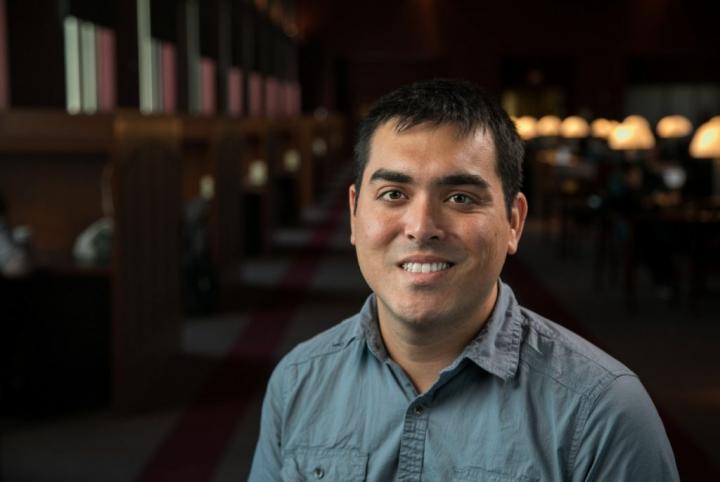
Credit: Virginia Tech
Scientists know a lot about evolution. And like, evolution, this knowledge is always changing, growing, becoming stronger. But for all the work done during a span of two centuries and change, scientists mostly have pictures of evolution’s history, unsorted and scattered.
Snapshot photographs if you will, strewn across a table. Josef Uyeda, an assistant professor and evolutionary biologist in the Virginia Tech Department of Biological Sciences, seeks to take all those “photographs” and make them into a photomosaic – you’ve seen them, often in movie posters or jigsaw puzzles – where hundreds of photographs are assembled to form a larger image of its own. (Say, a man’s face, or the New York City skyline.) More simply, Uyeda is taking on a massive connect-the-dots project that spans millions of years of evolution, in its smallest and largest forms, with an eye toward the future.
“Studies of ‘evolution-in-action’ have revealed much about what causes evolutionary change, including why it sometimes fails. However, it is not always obvious when these causes are also responsible for extinction and adaptation over million-year timescales — the timescale primarily relevant to the evolution and maintenance of biodiversity,” said Uyeda, a faculty member in the Virginia Tech College of Science and an affiliated member of the Virginia Tech Global Change Center.
Uyeda will use a $778,000 five-year National Science Foundation (NSF) Faculty Early Career Development (CAREER) Program grant to carry out his study. The CAREER award is the NSF’s most prestigious awards in support of early-career faculty who have the potential to serve as academic role models in research and education.
“The goal of the grant is really to take how we study evolution across the tree of life from simply looking for patterns of how traits are related, to understanding what causes them to evolve,” Uyeda added. “How traits might evolve in response to the environment, how traits might respond to each other and trying to connect those to what we do at the microevolutionary scale, where we understand how variable traits are, the genetics underlying them, how natural selection works, and the driving processes of evolution. The goal is to bridge these together, making models smarter and allowing them to take data from both scales, rather than simply making more complicated models. If we unite those two sides together, we can get better answers to what’s happening.”
To take it a step further, Uyeda wants to predict future evolution much like meteorologist predict weather patterns hurricanes, and winter storms. This ties to climate change, and the survival of scores of fauna and flora. In weather, micro-actions in the atmosphere can lead to major- and macro-events, the butterfly effect. We know when the sunlight hits the Earth, certain parts are warmed, and where the sun does not reach as much, it is cold. It’s the predictability that Uyeda wants to bring to the study of evolution.
“With increasing rates of global change, it is vital to understand how and why species either adapt and survive, or fail to adapt and perish,” Uyeda said. “This project will build a bridge between the causes of evolution studied over short timescales and the long-term outcomes evident from existing evolutionary diversity with a new set of computational tools and resources for biology research and education. New models will integrate field, genetic, and experimental studies with patterns of trait change from across the tree of life.”
The bulk of the study will use statistics and data modeling. “It’s all based of what’s called the comparative method,” Uyeda added. “We can’t do experiments at million-year time scales, but we can look across species and see if all the species that live in a warm environment are evolving faster, or maybe all the warm-blooded organisms are evolving faster than the cold-blooded organisms. But how do we know those traits are actually related to one another? Well, we have to try and understand the entire evolutionary history through time to make sense of the patterns we see, and we have to use models to fill in the evolutionary history that we don’t see.”
This, of course, is difficult. The data sets of evolution from across the globe, the “tree of life” as Uyeda says, the fossil record, and in modern day studies of “evolution in action” are often disconnected. So, Uyeda and his team – which includes graduate students, a post-doc, and partner universities, will hit at the project in pieces.
“We’re going to take a page out of how we study DNA evolution, which borrows heavily from things like the theory of population genetics, and the understanding of how mutation and DNA actually evolves, to construct the tree of life.” To do the same for traits, they will look at what’s known from the evolution of biomechanics, the underlying genetics of mammal tooth evolution, and the millennia of fossil records and integrate these together to connect patterns from short to long timescales.
“I have not collected most of the data myself, and it would be impossible for me to do so alone. But I am trying to pull together existing datasets and bring them together in a single analysis. If we do so, then we can start to connect the big picture patterns of evolution to the short time scales we often use to study it, where we understand cause and effect,” Uyeda said.
“We want to look to the past to inform what we do in the future, as these are changes play out over millions of years. If we don’t understand how those processes work, then how can we understand what the future impacts will be of what we are doing today?”
###
Media Contact
Steven Mackay
[email protected]




